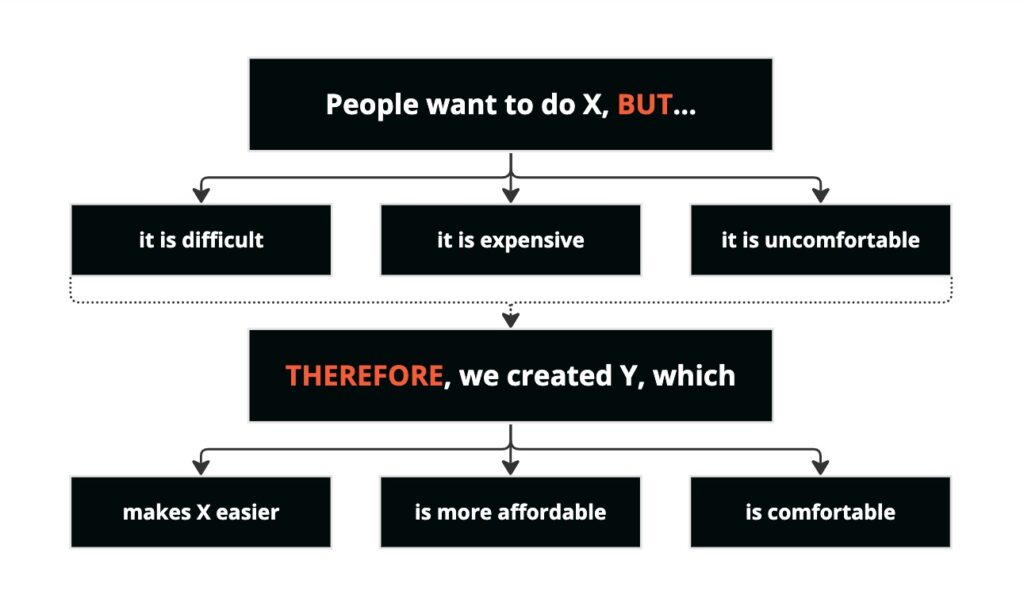Introduction
Clarifying your company’s message and business idea is essential for successful marketing and sales.
Even if your company has a solution to end world hunger, if it’s not communicated effectively to your audience, you’ll find yourself in the food line before you know it.
Today, even small businesses compete globally, so for your company to succeed, your idea and unique selling proposition must be crystal clear within the first few seconds.
I have conducted about 200 pitch workshops that have helped startups to public companies clarify their work into a few understandable and sellable sentences.
To give you some comfort, I can say that both large and small businesses struggle with clarifying their business idea.
The problem with large businesses is that they do many things and operate in many different fields. The problem with small businesses is that the people involved are too close to their operations.
However, both are too far from the primary needs of the customer.
Fortunately, there are many effective ways to clarify your message, from the Storybrand framework to Robert McKee’s controlling idea.
But the But/Therefore model works best for sales and marketing, in my experience. It is a straightforward communication framework that, once you adopt it, you will wonder how you ever managed without it.
The But/Therefore Model Clarifies Your Company’s Idea
If you must learn one thing today, it should be the But/Therefore model. I can assure you that this concept makes sales and marketing so much easier.
The ability to summarize complex concepts quickly into an easily digestible form is crucial, especially in email marketing, paid advertising, and landing page design.
A recipient or website visitor gives your material about 15 seconds to convince them to keep reading. Hence, a complex or unclear description of what your company does destroys the chances of conversion.
The But/Therefore model is often used in movie and TV scripts. The reason is simple: the But/Therefore model is basically a story in a nutshell.
People understand even tricky concepts easily when the story structure is used. In good stories, the audience is always given a frame first, then a challenge, and finally a solution.
When you tell your company’s concept in this order, even a child can understand and remember it later.
What Does the But/Therefore Model Look Like?
For clarity, let’s take Uber’s taxi service (from the consumer’s perspective) as an example.
Uber’s But/Therefore would go like this:
“People want to travel by taxi, but ordering them is difficult, pricing is unclear, and there is no guarantee that the driver can find the way. Therefore, Uber developed an application that allows the user to order a ride, pay the predetermined price directly from the app, and ensure that the driver finds the way.”
Clear, right?
The But/Therefore model should be applied according to the target audience.
For example, Uber has several But/Therefore sentences. Uber’s taxi service, from the driver’s perspective, would go like this:
“Many people would like to earn additional income by driving a taxi on the side, but becoming a part-time taxi driver is difficult, expensive, and too risky. Therefore, Uber created an application that allows anyone to become a driver without risk, accept gigs directly in the app, and choose working hours according to their lifestyle.”

Okay, maybe Uber’s example was too easy. What about a less-known example? Let’s take our growth marketing agency Growthland as an example.
Our But/Therefore would go like this:
“Companies need new leads to grow, but doing it yourself takes time, is unpleasant, and if you outsource it to booking agencies, the quality of the meetings is too low. Therefore, we created a fixed monthly growth marketing service that uses paid advertising, conversion-optimized landing pages, and email outreach to generate B2B leads.”
So, when a prospect reads the above section, they will understand much better what we do and how we stand out from other players.
After that, you can open up your operation more by listing the mentioned parts.
In our case, it might look something like this:
“To systematically and cost-effectively generate B2B leads without compromising quality, the lead generation process must include cold contact, paid advertising, and continuous optimization work based on data analytics.
At Growthland, we are not cold-calling bookers but growth hackers specializing in B2B lead generation. That’s why we approach lead generation from a growth marketing perspective instead of cold-calling. For this purpose, we built our own suite of digital lead generation tools, including 1-to-1 email outreach that reaches about 98% of recipients and produces 60-70% open rates and 20-30% response rates.
When combined with effective paid advertising and a conversion-optimized landing page with lead magnets, the result is a predictable and manageable increase in leads.
After that, it’s easy for the customer’s sales team to pick up the leads and turn them into new deals.
This is how we stand out from other growth marketing agencies:
- We package services into clear monthly service plans
- We display prices on our website
- We included a monthly advertising budget and regular growth marketing consulting work
- The customer can monitor our work and results in real-time from a tailored data board
- We never tie our customers into long-term contracts; instead, cooperation can be terminated at any time with 30 days’ notice.”
I guarantee that if you read the above description of our company’s operations, you now fully understand our model and why it makes sense to work with us.
Summary
When you start writing your own But/Therefore sentences, begin by telling what your customer wants, then present the problem and why it is difficult, expensive, and/or unpleasant today.
After that, present the reasons why your company’s solution exists and what the customer is willing to pay for.
Here’s a blank example template you can steal:
“People want to do X, but it is difficult, expensive, and/or uncomfortable. Therefore, we created Y, which enables people to do X more easily, affordably, and comfortably.”
Happy clarifying!
Mikael Hugg, Creative Director & Co-founder, Growthland
Do you want to comment? Tag me in your post on LinkedIn.
Growth hackers! If you liked the article and want to use it as a source on your website, send me a message on LinkedIn. I’ll link one of your articles to our future articles (as long as you don’t link no-follow). This way, both of our sites benefit from each other. 🙂
